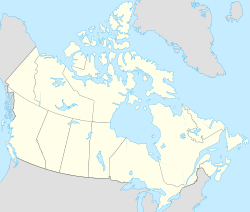Baker Lake, Northwest Territories
|
Baker Lake ᖃᒪᓂᑦᑐᐊᖅ Qamani'tuaq |
|
|---|---|
| Hamlet | |

Baker Lake, 1995
|
|
| Coordinates: 64°19′05″N 096°01′03″W / 64.31806°N 96.01750°WCoordinates: 64°19′05″N 096°01′03″W / 64.31806°N 96.01750°W | |
| Country | Canada |
| Territory | Nunavut |
| Region | Kivalliq Region |
| Electoral district | Baker Lake |
| Government | |
| • Type | Hamlet Council |
| • Mayor | Joseph Aupaluktuq |
| • MLAs | Simeon Mikkungwak |
| Area | |
| • Total | 182.22 km2 (70.36 sq mi) |
| • Population Centre | 1.57 km2 (0.61 sq mi) |
| Elevation | 18 m (59 ft) |
| Population (2016) | |
| • Total | 2,069 |
| • Density | 11/km2 (29/sq mi) |
| • Population Centre | 1,690 |
| • Population Centre density | 1,100/km2 (2,800/sq mi) |
| Time zone | CST (UTC−6) |
| • Summer (DST) | CDT (UTC−5) |
| Canadian Postal code | X0C 0A0 |
| Area code(s) | 867 |
| Website | www |
Baker Lake (Inuktitut syllabics: ᖃᒪᓂᑦᑐᐊᖅ, big lake joined by a river at both ends, Inuktitut: Qamani'tuaq, where the river widens), is a hamlet in the Kivalliq Region, in Nunavut on mainland Canada. Located 320 km (200 mi) inland from Hudson Bay, it is near the nation's geographical centre, and is notable for being the Canadian Arctic's sole inland community. The hamlet is located at the mouth of the Thelon River on the shore of Baker Lake. The community was given its English name in 1761 from Captain William Christopher who named it after Sir William Baker, the 11th Governor of the Hudson's Bay Company.
In 1916, the Hudson's Bay Company established a trading post at Baker Lake, followed by Anglican missionaries in 1927. The Royal Canadian Mounted Police had been in the area for fifteen years before establishing a post at Baker Lake in 1930. In 1946 the population was 32, of which 25 were Inuit. A small hospital was built in 1957, followed by a regional school the next year.
Videos of elders sharing oral histories have been collected by Inuit students as part of the Nunavut Teacher Education Program.
In the 2016 Census, Statistics Canada reported that Baker Lake had a population of 2,069 living in 580 of its 667 total dwellings, a 10.5% increase from its 2011 Census population of 1,872. With a land area of 182.22 km2 (70.36 sq mi), it had a population density of 11.4/km2 (29.4/sq mi) in 2016.
...
Wikipedia


